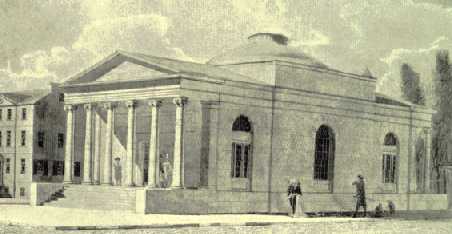Bank of Pennsylvania
- Benjamin Latrobe
 This bank, constructed in Philadelphia between 1799-1801, is a simple,
monumental structure. It has been termed the first monument of the Greek
Revival in the United States. It does have the first Greek order to appear
in America, although it was more Roman in style with its basic frontal
temple orientation. The bank is also highly representative of the work
of Laugier, Latrobe's teacher, so in a sense it is more representative
of European Neoclassiscm. There is nothing distinctly American, rather
than European, about this building.
This bank, constructed in Philadelphia between 1799-1801, is a simple,
monumental structure. It has been termed the first monument of the Greek
Revival in the United States. It does have the first Greek order to appear
in America, although it was more Roman in style with its basic frontal
temple orientation. The bank is also highly representative of the work
of Laugier, Latrobe's teacher, so in a sense it is more representative
of European Neoclassiscm. There is nothing distinctly American, rather
than European, about this building.
Latrobe used a great deal of vaulting for the interior space of this building
for mere architectural effect, the first of its kind in America.
It was beautifully simple in style, taking up a single city block, but
with an enlarged central block on both sides of the center of the building.
In the Greek style, each wing had an exterior portico. The end porticoes
are of the Greek ionic, modeled after the Temple of Illissus, although
Latrobe claimed he designed this building without the assistance of books.
The building has been demolished.
The Bank of Pennsylvania made strides in American building by incorporating
into the structure more advanced engineering techniques, such as vaulting
and a large dome. Both of these features were the result of Latrobe's training
in engineering. Despite its European flair, the Bank is very rational and
geometric, and essentially a spinoff of the traditional ancient temple.

